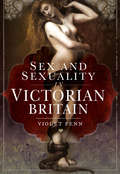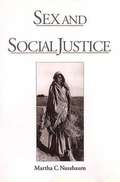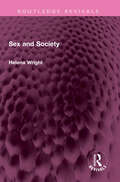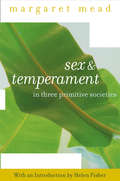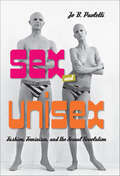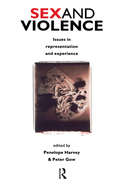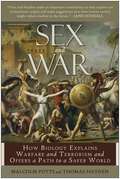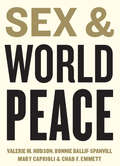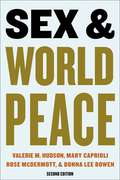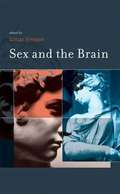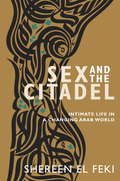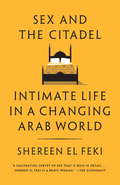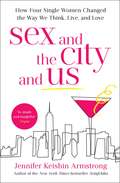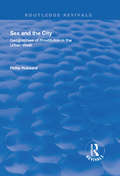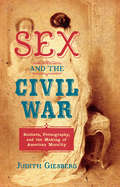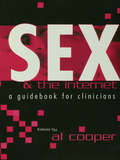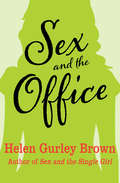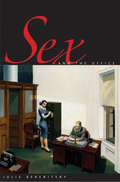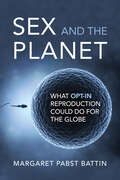- Table View
- List View
Sex and Sexuality in Victorian Britain
by Violet Fenn&“Dull this book is not, and it gives an insight into the many scandals not spoken about in polite Victorian drawing rooms.&” —Glasgow & West of Scotland Family History Society Peek beneath the bedsheets of nineteenth-century Britain in this affectionate, informative and fascinating look at sex and sexuality during the reign of Queen Victoria. It examines the prevailing attitudes towards male and female sexual behavior, and the ways in which these attitudes were often determined by those in positions of power and authority. It also explores our ancestors&’ ingenious, surprising, bizarre and often entertaining solutions to the challenges associated with maintaining a healthy sex life. Did the people in Victorian times live up to their stereotypes when it came to sexual behavior? This book will answer this question, as well as looking at fashion, food, science, art, medicine, magic, literature, love, politics, faith and superstition through a new lens, leaving the reader uplifted and with a new regard for the ingenuity and character of our great-great-grandparents. &“I would say this book gives you the information on relationships, genders and very much behavior that doesn&’t usually come across in history books. Therefore this is an excellent book indeed, certainly one that more people should be aware of and learn from.&” —UK Historian &“The writing is joyous and it is clear the author enjoys her subject and is fairly knowledgeable on things Victorian.&” —Rosie Writes &“Fenn&’s writing is so readable and it&’s clear this is a book written by a historian who loves her subject and is very knowledgeable about the research being carried out by other historians.&” —Jessticulates
Sex and Sexuality in Victorian Britain
by Violet Fenn&“Dull this book is not, and it gives an insight into the many scandals not spoken about in polite Victorian drawing rooms.&” —Glasgow & West of Scotland Family History Society Peek beneath the bedsheets of nineteenth-century Britain in this affectionate, informative and fascinating look at sex and sexuality during the reign of Queen Victoria. It examines the prevailing attitudes towards male and female sexual behavior, and the ways in which these attitudes were often determined by those in positions of power and authority. It also explores our ancestors&’ ingenious, surprising, bizarre and often entertaining solutions to the challenges associated with maintaining a healthy sex life. Did the people in Victorian times live up to their stereotypes when it came to sexual behavior? This book will answer this question, as well as looking at fashion, food, science, art, medicine, magic, literature, love, politics, faith and superstition through a new lens, leaving the reader uplifted and with a new regard for the ingenuity and character of our great-great-grandparents. &“I would say this book gives you the information on relationships, genders and very much behavior that doesn&’t usually come across in history books. Therefore this is an excellent book indeed, certainly one that more people should be aware of and learn from.&” —UK Historian &“The writing is joyous and it is clear the author enjoys her subject and is fairly knowledgeable on things Victorian.&” —Rosie Writes &“Fenn&’s writing is so readable and it&’s clear this is a book written by a historian who loves her subject and is very knowledgeable about the research being carried out by other historians.&” —Jessticulates
Sex and Social Justice
by Martha C. NussbaumWhat does it mean to respect the dignity of a human being? What sort of support do human capacities demand from the world, and how should we think about this support when we encounter differences of gender or sexuality? How should we think about each other across divisions that a legacy of injustice has created? In Sex and Social Justice, Martha Nussbaum delves into these questions and emerges with a distinctive conception of feminism that links feminist inquiry closely to the important progress that has been made during the past few decades in articulating theories of both national and global justice. Growing out of Nussbaum's years of work with an international development agency connected with the United Nations, this collection charts a feminism that is deeply concerned with the urgent needs of women who live in hunger and illiteracy, or under unequal legal systems. Offering an internationalism informed by development economics and empirical detail, many essays take their start from the experiences of women in developing countries. Nussbaum argues for a universal account of human capacity and need, while emphasizing the essential role of knowledge of local circumstance. Further chapters take on the pursuit of social justice in the sexual sphere, exploring the issue of equal rights for lesbians and gay men. Nussbaum's arguments are shaped by her work on Aristotle and the Stoics and by the modern liberal thinkers Kant and Mill. She contends that the liberal tradition of political thought holds rich resources for addressing violations of human dignity on the grounds of sex or sexuality, provided the tradition transforms itself by responsiveness to arguments concerning the social shaping of preferences and desires. She challenges liberalism to extend its tradition of equal concern to women, always keeping both agency and choice as goals. With great perception, she combines her radical feminist critique of sex relations with an interest in the possibilities of trust, sympathy, and understanding. Sex and Social Justice will interest a wide readership because of the public importance of the topics Nussbaum addresses and the generous insight she shows in dealing with these issues. Brought together for this timely collection, these essays, extensively revised where previously published, offer incisive political reflections by one of our most important living philosophers.
Sex and Society (Routledge Revivals)
by Helena WrightFirst published in 1968, Sex and Society presents and analyses the code of sexual behaviour based on the universal use of contraceptive methods. It includes discussion of all forms of sexual activity, and emphasises in particular the attitudes that should be adopted in sex education. Backed up by case histories, and including details of reforms in abortion and homosexual law, this book sheds light on a topic which continues to cause concern in modern times. The author had been in active contact with all kinds of sexual problems for over thirty years in her professional clinic practice, and in her travels in India, Poland and Denmark teaching contraceptive techniques to doctors and nurses. Her experience as a Founder Member of the International Planned Parenthood Federation and participation in all the International and Regional Conferences gave her a very wide knowledge of sexual and social problems throughout the world. This book will be of interest to students of medicine, sexuality studies, psychology, gender studies, and health.
Sex and Temperament
by Margaret MeadFirst published in 1935, Sex & Temperament is a fascinating and brilliant anthropological study of the intimate lives of three New Guinea tribes from infancy to adulthood. Focusing on the gentle, mountain-dwelling Arapesh, the fierce, cannibalistic Mundugumor, and the graceful headhunters of Tchambuli -- Mead advances the theory that many so-called masculine and feminine characteristics are not based on fundamental sex differences but reflect the cultural conditioning of different societies. This edition, prepared for the centennial of Mead's birth, features introductions by Helen Fisher and Mead's daughter, Mary Catherine Bateson.A precursor to Mead's illuminating Male & Female, Sex & Temperament lays the groundwork for her lifelong study of gender differences.
Sex and Temperament in Three Primitive Societies
by Margaret MeadMargaret Mead's analysis of sex and gender from anthropological research in three New Guinea tribes.
Sex and Tourism: Journeys of Romance, Love, and Lust
by Thomas Bauer Bob Mckercher Kaye Sung ChonExplore the complex relationship between tourism and intimacy in this new book with a worldwide perspective! With a unique combination of academic and personal accounts, Sex and Tourism: Journeys of Romance, Love, and Lust takes you behind the scenes with motel owners, adventure travel guides, backpackers, and others working on all sides of the international tourism industry. The editors have created a model that views the situation from three different perspectives: tourist, tourism provider, and nature of the encounter. Unlike other related volumes, this book is not just about the sex trade, but also about the role of tourism in love, marriage, and relationships. The global focus of Sex and Tourism will introduce you to: off-season romance on the island of Crete sex tourism in Cambodia a South Korean museum dedicated to women forced into sexual slavery by the Japanese military the sexual aspects of adventure travel in Canada cross-cultural marriage in Thailand gentleman's clubs in New Orleans Australian river guides and their potential liaisons with clients People who travel to escape their day-to-day lives often become involved in situations they would never find themselves in at home. Good or bad, many of these situations are examined in Sex and Tourism. You'll learn about the illegal trafficking of girls in Nepal, worldwide programs for combating child sex rings, and the lethal combination of AIDS and tourism, but you'll also find accounts of love and romance far from home. You will see how the tourism industry can act as a facilitator of human intimacy and what happens when different cultural realities collide. Anyone involved in recreation, leisure, anthropology, social science, or tourism will be interested in this book. Sex and Tourism is an enlightening guide to the complex world found at the crossroads of sightseeing and sex.
Sex and Unisex: Fashion, Feminism, and the Sexual Revolution
by Jo B. PaolettiNotorious as much for its fashion as for its music, the 1960s and 1970s produced provocative fashion trends that reflected the rising wave of gender politics and the sexual revolution. In an era when gender stereotypes were questioned and dismantled, and when the feminist and gay rights movements were gaining momentum and a voice, the fashion industry responded in kind. Designers from Paris to Hollywood imagined a future of equality and androgyny. The unisex movement affected all ages, with adult fashions trickling down to school-aged children and clothing for infants. Between 1965 and 1975, girls and women began wearing pants to school; boys enjoyed a brief "peacock revolution," sporting bold colors and patterns; and legal battles were fought over hair style and length. However, with the advent of Diane Von Furstenberg's wrap dress and the launch of Victoria's Secret, by the mid-1980s, unisex styles were nearly completely abandoned. Jo B. Paoletti traces the trajectory of unisex fashion against the backdrop of the popular issues of the day—from contraception access to girls' participation in sports. Combing mass-market catalogs, newspaper and magazine articles, cartoons, and trade publications for signs of the fashion debates, Paoletti provides a multigenerational study of the "white space" between (or beyond) masculine and feminine.
Sex and Violence: The Psychology of Violence and Risk Assessment
by Penelope HarveyProduced in response to the growing international demand for information, this book details the latest research in understanding and controlling violent and sexual offences. Increasing numbers of psychologists are now studying and working with offenders to the advancement of forensic psychology.Chapters cover contributions from ten different countries and are grouped into three sections dealing with risk assessment, sex offenders and offences and violent offenders and offences. The first section discusses the progress that has been made towards making accurate decisions about the risk that an individual poses to the community and emphasises the need to draw on both clinical experience and research.The second section explores understandings and investigations of sexual offences including discussion on: American commitment laws for sexually violent predators; the status of "recovered memories" in criminal trials; factors influencing delays in reporting sexual abuse; a model of rapists' accounts of their offences; and situational factors in sexual offending.The final section on violent offenders and offences includes discussion on: criminal careers; domestic violence; mutiliation-murder in Japan; offender profiling; and sentencing of homicide cases.This book will be of interest to scholars in criminology, psychology and forensic psychiatry and to policy-makers and practitioners who deal with sexual and violent offences.
Sex and War: How Biology Explains Warfare and Terrorism and Offers a Path to a Safer World
by Thomas Hayden Malcolm PottsAs news of war and terror dominates the headlines, scientist Malcolm Potts and veteran journalist Thomas Hayden take a step back to explain it all. In the spirit of Guns, Germs and Steel, Sex and War asks the basic questions: Why is war so fundamental to our species? And what can we do about it? Malcolm Potts explores these questions from the frontlines, as a witness to war-torn countries around the world. As a scientist and obstetrician, Potts has worked with governments and aid organizations globally, and in the trenches with women who have been raped and brutalized in the course of war. Combining their own experience with scientific findings in primatology, genetics, and anthropology, Potts and Hayden explain war's pivotal position in the human experience and how men in particular evolved under conditions that favored gang behavior, rape, and organized aggression. Drawing on these new insights, they propose a rational plan for making warfare less frequent and less brutal in the future. Anyone interested in understanding human nature, warfare, and terrorism at their most fundamental levels will find Sex and War to be an illuminating work, and one that might change the way they see the world.
Sex and World Peace
by Valerie Hudson Bonnie Ballif-Spanvill Mary Caprioli Chad EmmettSex and World Peace unsettles a variety of assumptions in political and security discourse, demonstrating that the security of women is a vital factor in the security of the state and its incidence of conflict and war. The authors compare micro-level gender violence and macro-level state peacefulness in global settings, supporting their findings with detailed analyses and color maps. Harnessing an immense amount of data, they call attention to discrepancies between national laws protecting women and the enforcement of those laws, and they note the adverse effects on state security of abnormal sex ratios favoring males, the practice of polygamy, and inequitable realities in family law, among other gendered aggressions. The authors find that the treatment of women informs human interaction at all levels of society. Their research challenges conventional definitions of security and democracy and shows that the treatment of gender, played out on the world stage, informs the true clash of civilizations. In terms of resolving these injustices, the authors examine top-down and bottom-up approaches to healing wounds of violence against women, as well as ways to rectify inequalities in family law and the lack of parity in decision-making councils. Emphasizing the importance of an R2PW, or state responsibility to protect women, they mount a solid campaign against women's systemic insecurity, which effectively unravels the security of all.
Sex and World Peace
by Rose McDermott Valerie Hudson Donna Lee Bowen Mary CaprioliSex and World Peace is a groundbreaking demonstration that the security of women is a vital factor in the occurrence of conflict and war, unsettling a wide range of assumptions in political and security discourse. Harnessing an immense amount of data, it relates microlevel violence against women and macrolevel state peacefulness across global settings.The authors find that the treatment of women informs human interaction at all levels of society. They call attention to the adverse effects on state security of sex-based inequities such as sex ratios favoring males, the practice of polygamy, and lax enforcement of national laws protecting women. Their research challenges conventional definitions of security and democracy and common understandings of the causes of world events. The book considers a range of ways to remedy these injustices, including top-down and bottom-up approaches to redressing violence against women and the lack of sex parity in decision-making. Advocating a state responsibility to protect women, the authors campaign against women’s systemic insecurity, which threatens the security of all.Sex and World Peace has been a go-to book for instructors, advocates, and policy makers since its publication in 2012. Since then, there have been major changes in world affairs, including the #MeToo movement, as well as advances in both theoretical and empirical literature surrounding the subject. This second edition, which adds coauthors Rose McDermott and Donna Lee Bowen alongside Valerie M. Hudson and Mary Caprioli, revises and updates the book for a new generation. The book retains its foundational overview of the relationship between women’s oppression and war, enhanced by fresh data and new material covering recent developments for global women’s rights and analysis of additional examples of gender and conflict throughout the world.
Sex and the Brain
by Gillian EinsteinThis collection of foundational papers on sex differences in the brain traces the development of a much-invoked, fast-growing young field at the intersection of brain and behavior. The reader is introduced to the meaning and nature of sexual dimorphisms, the mechanisms and consequences of steroid hormone action, and the impact of the field on interpretations of sexuality and gender. Building on each other in point-counterpoint fashion, the papers tell a fascinating story of an emerging science working out its core assumptions. Experimental and theoretical papers, woven together by editor's introductions, open a window onto knowledge in the making and a vigorous debate between reductionist and pluralist interpreters. Five major sections include papers on conceptual and methodological background, central nervous system dimorphisms, mechanisms for creating dimorphisms, dimorphisms and cognition, and dimorphisms and identity. Each section builds from basic concepts to early experiments, from experimental models to humans, and from molecules to mind. Papers by such leading scholars as Arthur Arnold, Frank Beach, Anne Fausto-Sterling, Patricia Goldman-Rakic, Doreen Kimura, Simon LeVay, Bruce McEwen, Michael Merzenich, Bertram O'Malley, Geoffrey Raisman, and Dick Swaab, illustrate a rich blend of perspectives, approaches, methods, and findings. Sex and the Brainwill show students how a scientific paper can be analyzed from many perspectives, and supply them with critical tools for judging a rapidly emerging science in a contentious area.
Sex and the Citadel: Intimate Life in a Changing Arab World
by Shereen El FekiIn the political unrest that swept across the Arab region in 2011, all eyes were on the streets and squares erupting in protest. But for the past four years, Shereen El Feki has been looking at upheaval a little closer to home -- in the sexual lives of men and women across the Arab world. The result is Sex and the Citadel, an informative, insightful and engaging account of a highly sensitive and still largely secret aspect of Arab society.Sex might seem a strange lens with which to examine change in the Arab world; it is, in fact, a prism with which to refract the region's complex social spectrum. Sexual attitudes and behaviours are intimately bound up in religion, culture, politics and economics. As such, they are not only a reflection of the conditions that led to the recent uprisings, as well as one of the engines of revolt, but will also be a measure of hard-won reforms in the years to come. Sex and the Citadel is no peep show. By linking sexuality to political, economic, social and religious trends, it opens a window on the greater landscape of the Arab world, both for readers new to the region whose interest has been sparked by recent events, and for old hands familiar with the Arab world. Nor is the book an academic treatise: this is a highly personal account, rich with original research and first-person stories, that gives us unprecedented and timely insight into a part of the world that is transforming in front of our very eyes.
Sex and the Citadel: Intimate Life in a Changing Arab World
by Shereen El FekiIf you really want to know a people, start by looking inside their bedrooms. As political change sweeps the streets and squares, the parliaments and presidential palaces of the Arab world, Shereen El Feki has been looking at an upheaval a little closer to home--in the sexual lives of men and women in Egypt and across the region. The result is an informative, insightful, and engaging account of a highly sensitive and still largely secret aspect of Arab society. Sex is entwined in religion, tradition, politics, economics, and culture, so it is the perfect lens through which to examine the complex social landscape of the Arab world. From pregnant virgins to desperate housewives, from fearless activists to religious firebrands, from sex work to same-sex relations, Sex and the Citadel takes a fresh look at the sexual history of the region and brings new voices to the debate over its future. This is no peep show or academic treatise but a highly personal and often humorous account of one woman's journey to better understand Arab society at its most intimate and, in the process, to better understand her own origins. Rich with five years of groundbreaking research, Sex and the Citadel gives us a unique and timely understanding of everyday lives in a part of the world that is changing before our eyes.
Sex and the City
by Candace BushnellA columnist's examination of the celebrity affairs and sexual link indulged in by the members of high society is seen through the experiences of a troubled writer, a mega-businessman, a famous underwear model, and others.
Sex and the City and Us: How Four Single Women Changed the Way We Think, Live, and Love
by Jennifer Keishin ArmstrongThe bestselling author of Seinfeldia offers a fascinating retrospective of the iconic and award-winning television series, Sex and the City, in a &“bubbly, yet fierce cultural dissection of the groundbreaking show&” (Chicago Tribune).This is the story of how a columnist, two gay men, and a writers&’ room full of women used their own poignant, hilarious, and humiliating stories to launch a cultural phenomenon. They endured shock, slut-shaming, and a slew of nasty reviews on their way to eventual—if still often begrudging—respect. The show wasn&’t perfect, but it revolutionized television for women. When Candace Bushnell began writing for the New York Observer, she didn&’t think anyone beyond the Upper East Side would care about her adventures among the Hamptons-hopping media elite. But her struggles with singlehood struck a chord. Beverly Hills, 90210 creator Darren Star brought her vision to an even wider audience when he adapted the column for HBO. Carrie, Miranda, Charlotte, and Samantha launched a barrage of trends, forever branded the actresses that took on the roles, redefined women&’s relationship to sex and elevated the perception of singlehood. Featuring exclusive new interviews with the cast and writers, including star Sarah Jessica Parker, creator Darren Star, executive producer Michael Patrick King, and author Candace Bushnell, &“Jennifer Keishin Armstrong brings readers inside the writers&’ room and into the scribes&’ lives…The writing is fizzy and funny, but she still manages an in-depth look at a show that&’s been analyzed for decades, giving readers a retrospective as enjoyable as a $20 pink cocktail&” (The Washington Post). Sex and the City and Us is both a critical and nostalgic behind-the-scenes look at a television series that changed the way women see themselves.
Sex and the City: Geographies of Prostitution in the Urban West (Routledge Revivals)
by Philip HubbardThis title was first published in 2000: Prostitution has always played a crucial symbolic role in the definition of moral and sexual standards and, as such, the figure of the prostitute has been paradigmatic in the history of the sex and the city. Focusing on the geographies of female prostitution in Western societies, this book explores the nature of sites of sex work and the ways they shape the lives of prostitutes (and their clients). In so doing, the book aims not simply to present a static "mapping" of sex work, but seeks to highlight how these public and private ssites are struggled over, with prostitutes often resisting the strategies of social and legal control designed to regulate their working practices. The book consequently engages with a number of contemporary debates in social, cultural and gender geography surrounding the importance of public and private spaces in producing (and reproducing) gender, sex and bodily identities.
Sex and the Civil War: Soldiers, Pornography, and the Making of American Morality (The Steven and Janice Brose Lectures in the Civil War Era)
by Judith GiesbergCivil War soldiers enjoyed unprecedented access to obscene materials of all sorts, including mass-produced erotic fiction, cartes de visite, playing cards, and stereographs. A perfect storm of antebellum legal, technological, and commercial developments, coupled with the concentration of men fed into armies, created a demand for, and a deluge of, pornography in the military camps. Illicit materials entered in haversacks, through the mail, or from sutlers; soldiers found pornography discarded on the ground, and civilians discovered it in abandoned camps. Though few examples survived the war, these materials raised sharp concerns among reformers and lawmakers, who launched campaigns to combat it. By the war's end, a victorious, resurgent American nation-state sought to assert its moral authority by redefining human relations of the most intimate sort, including the regulation of sex and reproduction—most evident in the Comstock laws, a federal law and a series of state measures outlawing pornography, contraception, and abortion. With this book, Judith Giesberg has written the first serious study of the erotica and pornography that nineteenth-century American soldiers read and shared and links them to the postwar reaction to pornography and to debates about the future of sex and marriage.
Sex and the Family in Colonial India: The Making of Empire
by Durba GhoshIn the early years of the British empire, cohabitation between Indian women and British men was commonplace and to some degree tolerated. However, as Durba Ghosh argues in a challenge to the existing historiography, anxieties about social status, appropriate sexuality, and the question of who could be counted as 'British' or 'Indian' were constant concerns of the colonial government even at this time. By following the stories of a number of mixed-race families, at all levels of the social scale, from high-ranking officials and noblewomen to rank-and-file soldiers and camp followers, and also the activities of indigenous female concubines, mistresses and wives, the author offers a fascinating account of how gender, class and race affected the cultural, social and even political mores of the period. The book makes an original and signal contribution to scholarship on colonialism, gender and sexuality.
Sex and the Internet: A Guide Book for Clinicians
by Al CooperFirst Published in 2002. Routledge is an imprint of Taylor & Francis, an informa company.
Sex and the Married Girl: Heterosexual Marriage and the Body in Postwar Canada (Studies in Gender and History)
by Heather StanleySex – who was having it, who shouldn’t have it, and who was supposed to be having it but wasn’t – was a major concern to social authorities in the immediate postwar era. Though they are often remembered with nostalgia as a sexually simpler time, the 1950s and early 1960s were incredibly sexually productive years. Sex and the Married Girl examines how two interrelated and dominant groups in Canada – medical professionals and church leaders – used married heterosexual female sexuality as a lever to rebuild the Canadian family and the state itself. Using embodied historical methodologies, the book examines not only discourses around sex but also how those discourses could influence the actual experience of sex for married women. Heather Stanley draws upon extensive oral life histories of women who lived, married, and had sex during this liminal social period to demonstrate that this was a time of simultaneous sexual and gender quiescence and change.
Sex and the Office
by Helen Gurley BrownHelen Gurley Brown adds dazzle to dull office days in her follow-up to the phenomenal bestseller Sex and the Single Girl The classic book from 1965 tells what it was really like to be the girl in a Mad Men–style workplace. Sex and the Office became the definitive, comprehensive guide to working life for an entire generation of women. Alongside advice about how to deal with your boss, manage office politics, and make the most of personal and professional opportunities in the office, Helen Gurley Brown also shares stories from her own office days. A classic of its time, this stands as a frank look at how to get ahead, not just through working hard but through playing hard, too.
Sex and the Office
by Julie BerebitskyIn this engaging book—the first to historicize our understanding of sexual harassment in the workplace—Julie Berebitsky explores how Americans’ attitudes toward sexuality and gender in the office have changed since the 1860s, when women first took jobs as clerks in the U. S. Treasury office. Berebitsky recounts the actual experiences of female and male office workers; draws on archival sources ranging from the records of investigators looking for waste in government offices during World War II to the personal papers ofCosmopolitaneditor Helen Gurley Brown andMs. magazine founder Gloria Steinem; and explores how popular sources—including cartoons, advertisements, advice guides, and a wide array of fictional accounts—have represented wanted and unwelcome romantic and sexual advances. This range of evidence and the study’s long scope expose both notable transformations and startling continuities in the interplay of gender, power and desire at work.
Sex and the Planet: What Opt-In Reproduction Could Do for the Globe (Basic Bioethics)
by Margaret Pabst BattinWhat if human reproduction was always elective? A prominent bioethicist speculates about the possibilities—and the likely consequences.What would the world be like if all pregnancy was intended, not unintended as it is nearly half the time now? Considerably better, Margaret Pabst Battin suggests in Sex and the Planet, a provocative thought experiment with far-reaching real-world implications. Many of the world&’s most vexing and seemingly intractable issues begin with sex—when sperm meets egg, as Battin puts it—abortion, adolescent pregnancy, high-risk pregnancy, sexual violence, population growth and decline. Rethinking reproductive rights and exposing our many mistaken assumptions about sex, Sex and the Planet offers an optimistic picture of how we might solve these problems—by drastically curtailing unintended pregnancies using currently available methods.How we see this picture—as recommendation, prediction, utopian fantasy, totalitarian plot, hypothetical conjecture, or realistic solution—depends to a great degree on which of thirteen problematic assumptions we maintain, assumptions Battin works to identify and challenge. Taking on sensitive topics like abortion and rape and religious issues around contraception, she shows how a fully informed, nonideological approach could defuse much of the friction such issues tend to generate. Also, in her attention to male contraception and the asymmetry of female and male reproductive control, she pulls in the 50 percent of the human race—those with Y chromosomes—largely left out of discussions of reproductive health. Sex and the Planet, finally, takes a global view, inviting us to consider a possible—even plausible—reproductive future.
